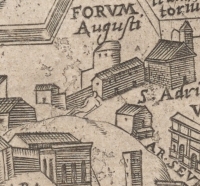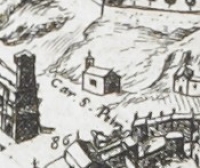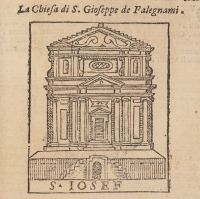San Pietro in Carcere is the site where, according to tradition, the apostles Peter and Paul were incarcerated for nine months before their martyrdoms. [1] The church claims an ancient and illustrious foundation by Pope Sylvester I (reigned 314–335), the pontiff who baptized the first Christian emperor, Constantine the Great (reigned 307–333), who, in turn, granted substantial privileges to the Roman Church. According to the legend transmitted via early modern sources, after a visit to the site Constantine recommended that the pontiff consecrate a church there. [2] The church then became an important pilgrimage destination because of its connection with the two apostles. In the early modern period, structural modifications to the site were made for Jubilee years, when pilgrims flocked to Rome. Despite drastic changes throughout the city over the centuries, the Church of San Pietro in Carcere maintained its privileged status as an important locus of early Christianity.
- Filters:
- Sort by:
- Results layout:
Selected Bibliography
Caiola, Antonio Federico, and Luciana Cassanelli. Roma sacra: Guida alle chiese della città eterna. 3. Pozzuoli (Naples), 1995.
Di Giacomo, Giovanna. Il complesso del Carcer-Tullianum sotto la Chiesa di S. Giuseppe dei Falegnami. Rome, 2009.
Felini, Pietro Martire, and Prospero Parisio. Trattato nuovo delle cose maravigliose dell'alma citta' di Roma. Rome, 1615.![]()
Gorski, Gilbert, and James E. Packer. The Roman Forum: A Reconstruction and Architectural Guide. New York, 2015.
Hibbard, Howard. "Di alcune licenze rilasciate dai Mastri di Strade per opere di edificazione a Roma (1586‒89, 1602‒34)." Bollettino d'arte 52 (1967): 99–101.
Panciroli, Ottavio. I tesori nascosti nell'alma città di Roma raccolti, e posti in luce per opera d'Ottauio Panciroli teologo da Reggio. Rome, 1600.
Panciroli, Ottavio. Tesori nascosti dell'alma città di Roma. Rome, 1625.![]()
Piatti, Tomaso. Il carcere Mamertino: La chiesa di S. Giuseppe dei falegnami e il santuario del SS. Crocifisso. Rome, 1938.
Totti, Pompilio. Ritratto di Roma moderna. Rome, 1638.![]()
Varisco, Giovanni. Le Cose meravigliose dell'alma città di Roma. Venice, 1565.
Ugonio, Pompeo. Historia delle stationi di Roma che si celebrano la Quadragesima. Rome, 1588.

Figure 1. Pirro Ligorio, Urbis Romae, detail of Marforius statue, c. 1552–1573, etching. Collection of Fredrika and Paul Jacobs

Figure 2. Étienne Dupérac, Nova Urbis Romae Descriptio, detail of the Church of San Pietro in Carcere, 1577, etching. London, The British Library
From an urban perspective, the church had only a marginal location in the early modern period, but the site, at the foot of the hill across from the Capitoline facing the Arch of Septimius Severus, had been at the center of civic life in ancient Roman times. The famous statue of Marforius, which once stood near the church as one can see in Pirro Ligorio’s map [fig. 1], gave its name to the adjacent street. The church was a two-level subterranean structure with an irregular plan, atypical for a church; it reflected the inherited structure of the prison. The ancient prison had been carved into the hill near the Campidoglio, behind the Church of Santa Maria in Aracoeli, and had a ground-level component that would subsequently disappear. [3] In his reconstruction of ancient Rome, Ligorio proposed a substantially large building which would have corresponded to the upper level. However, as in the case of other monuments still at least partially extant at the time, Ligorio’s vision of ancient structures was equally informed by their contemporaneous features. Therefore, the building may have denoted the church of San Giuseppe dei Falegnami, which was built on top of San Pietro in Carcere after a group of carpenters moved there in 1540. [4] Yet the building lacked the bell tower added by the carpenters in 1563—a detail visible on Dupérac’s 1577 map [fig. 2] but justifiably absent on Ligorio’s map if the latter had drawn the area before the construction of the bell tower. On the other hand, Ligorio showed the structure equipped with a narthex, a feature absent in Dupérac’s map. Sebastiano de Re’s map (1557) cannot be adduced as evidence of the church’s appearance when comparing Ligorio’s and Dupérac’s map as it shows neither labels nor a particular focus on this area.

Figure 3. Matteo Florimi, Novissima urbis romae descriptio, detail of Church of San Giuseppe dei Falegnami, c. 1590-1613, ething and engraving. Collection of Fredrika and Paul Jacobs
Intriguingly, the much later map of Matteo Florimi (c. 1590–1613 [fig. 3]) rendered the church of San Giuseppe similarly to Ligorio’s rather than to Dupérac’s version. Whether or not Ligorio aimed to recreate the ancient structure, its more relevant sections to San Pietro in Carcere were the subterranean ones. Pompeo Ugonio (1588), Ottavio Panciroli (1600), and Pompilio Totti (1630) report that the more ancient space would have been the upper level of the prison, the lower one being excavated two regimes later. [5] In fact, the lower level is datable to approximately the 7th to 6th century BCE and the upper level to the Republican period (6th to 1st century BCE). [6] The prison was also called the Carcer Tullianum, either from the Roman king Servius Tullius, who added the lower level of the prison, or from a spring (tullius in Latin) present in that space. [7] Early modern sources refer to the prison either as Tulliano, according to ancient custom, or Mamertino, following period custom. [8] The latter appellation supposedly derived either from the ancient Roman king Ancus Marcius or from the name of a prefect of Rome of an unspecified time. [9]
Each level played a different role in ecclesiastical practices at the site. The upper level was associated with an image of Saint Peter that, according to legend, resulted from an imprint made when the saint hit his head against a wall as he was pushed down the stairs. It was supposedly worn to the point of illegibility from longstanding veneration by believers, which included touching it. The portion of wall bearing its traces was removed to create a door for easy access to the site for the Jubilee of 1600. [10] Totti called the carpenters “ignorant” for taking such reckless action. Practical issues such as topography and accessibility and technical details such as thickness of the wall must be considered in any discussion of whether they were unaware of the image or made a conscious decision. It is known, however, that around 1597 the carpenters were rebuilding the Church of San Giuseppe dei Falegnami on top of the Church of San Pietro in Carcere. While we lack visual evidence for this specific moment, we can imagine the site obstructed by scaffolding and littered with building materials. Confronted with the necessity of making the site accessible to pilgrims, the carpenters may have opted for the solution that promised the least interference with construction. The removal was supposedly redressed in the early 18th century when an image, alleged to be the portion of the wall bearing the impression, was placed behind a protective grille in the upper chamber of the old prison. [11]
The lower level of the Church of San Pietro in Carcere was linked to a miracle performed by the two apostles while incarcerated there: the emergence of a spring. [12] Sources from the 17th century questioned the authenticity of the fountain then at the site because various buildings and fountains had over centuries come to light in the Campidoglio area. [13] In the same underground space was preserved the column to which the two apostles had been chained. Later this space came to be called the Carcer Tullianum, whereas the upper space was considered the Church of San Pietro proper. [14] Early modern sources, however, conceived of the two levels as a single unit constituting the Church of San Pietro in Carcere. [15]

Figure 4. Pietro Felini and Prospero Parisio, Church of San Giuseppe dei Falegnami, in Trattato nuovo delle cose maravigliose dell'alma citta' di Roma, 1615, p. 153. National Gallery of Art Library, Rare (NA1120 .F44 1615)
Early modern depictions of the church are rare. Contemporary maps showed buildings only at surface level. In an illustration included in Pietro Martire Felini’s Trattato (1615 [fig. 4]), the Church of San Pietro in Carcere appears clearly distinguished from that superimposed on it (San Giuseppe dei Falegnami, recently completed in 1602). [16] The structure of San Pietro protrudes, creating a platform in front of the facade of the Church of San Giuseppe. The construction materials are evidently different, the masonry of San Pietro in Carcere being made of rougher ones. The entrance to the lower church is delineated by a large doorframe. Two flights of stairs offer access between the two churches. The epigraph inscribed on the occasion of the restoration of the stairs for the Jubilee of 1625 claims that the space of the Church of San Pietro had remained intact. [17]
The dedication of the church was expanded to include Saints Peter, Paul, and Joseph after the carpenters succeeded in 1540 in securing the site from the rector (rettore) of the nearby Church of Santa Martina, under whose jurisdiction the Church of San Pietro in Carcere resided at the time. [18] When the carpenters decided to build a separate and elaborate structure above the church, the dedication of the ancient church was restored to Saints Peter and Paul, whereas the upper church was dedicated to Saint Joseph, the patron saint of the carpenters. When the painters and sculptors moved into the nearby Church of Santa Martina in 1588, the Arciconfraternita di San Giuseppe had been at the Church of San Pietro in Carcere for almost half a century, during which time they had built a church on top of it. The recorded interactions between the Accademia di San Luca and the carpenters concerned the contested jurisdiction over the site. Discussions most frequently involved the leaders of the Arciconfraternita, but the Church of San Pietro in Carcere occasionally surfaces in the Accademia’s documents as well. [19] In some cases, they refer to the site in relation to earlier transactions when San Pietro in Carcere was first known as such. [20]
~ Silvia Tita, revised August 2021
[1] Varisco 1565, 21; Ugonio 1588, 49v; Totti 1638, 420.
[2] See, for instance, Totti 1638, 420.
[3] For a reconstruction of the Roman Forum, including monuments near the prison, see Gorski and Packer 2015.
[4] For all these issues, see the entry on the Church of San Giuseppe dei Falegnami.
[5] According to Totti, the Roman king Ancus Marcius (642‒617 BCE) built the upper chamber and Servius Tullius (active 578–535 BCE) created the lower one two generations later (Totti 1638, 419; also Ugonio 1588, 263, and Panciroli 1600, 663). Ugonio refers only to the temporal issues. For his ancient sources on the Tullian prison, see 245–276. In contrast to Totti, Livy, the most informative ancient source on the topic, dated the two spaces the other way around.
[6] Di Giacomo, 2009, 10.
[7] As mentioned below, Christians believed the spring to have surfaced from a miracle of the two apostles, but it may have existed on the spot from ancient times.
[8] Ugonio 1588, 49v, 232; Panciroli 1600, 632; Totti 1638, 420.
[9] For the former, see, for instance, Panciroli 1600, 632; for the latter, see Totti 1638, 420.
[10] For this story, see Totti 1638, 420.
[11] As seen in an 1855 engraving by Giacomo Fontana.
[12] As the legend was transmitted, the two apostles baptized with this water the two soldiers who were guarding them (Saint Processo and Saint Martiniano) and forty-seven other prisoners. Varisco 1565, 21; Ugonio 1588, 49v.
[13] Totti 1638, 420.
[14] The legend of Giacomo Fontana’s engraving of 1855 indicates this understanding. Some modern scholarship echoes this stratification of the interior of the church.
[15] Panciroli 1600, 323; Totti 1638, 419–420.
[16] Felini 1615, 153.
[17] “In honorem Dei, & Ecclesiae ornamentum; Intacto ss.Petri & Pauli carcere scalas, & fornicem S. Iosephi Carpentariorurn Archiconfraternitas restaurauit.” Totti 1638, 420.
[18] Along with the church, they secured several adjacent houses to be used for the Compagnia’s business (see Anderson 2009, 294).
[19] On negotiations between the Arciconfraternita and the Accademia concerning the carpenters’ occupancy of the site, see the entry on the Church of San Giuseppe dei Falegnami.
[20] ASR, TNC, uff. 15, 1625, pt. 1, vol. 103, fols. 462r, 467v.

